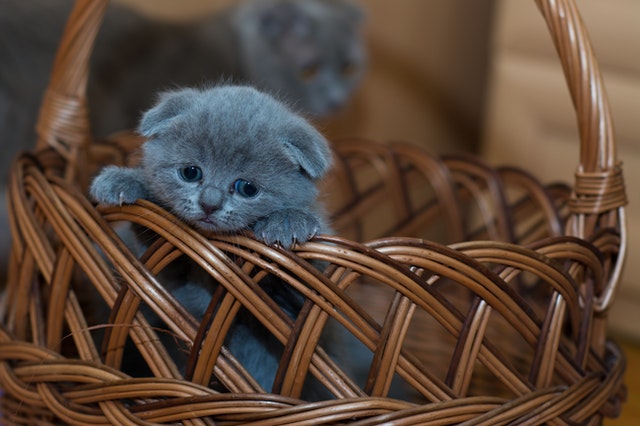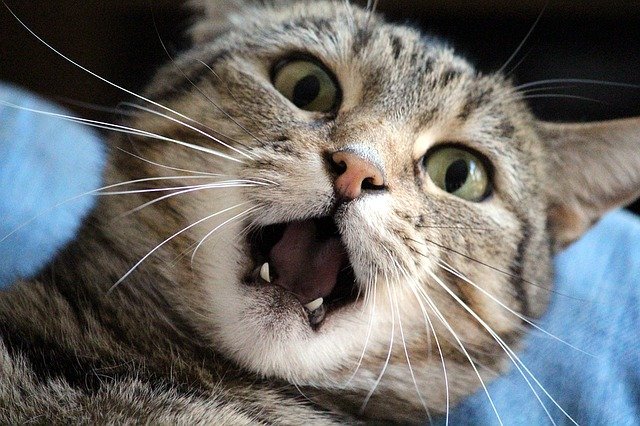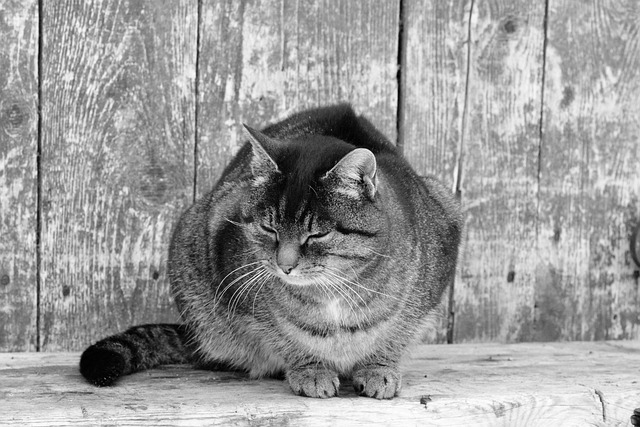You might taunt your friend for being such a “scaredy-cat” or have a good laugh when someone scares your kitten, and it could be fun to see when they jump. A terrified, worried cat, on the other hand, is not a laughing matter.
Anxiety and stress may have a severe impact on a person’s health. Stress and anxiety have similar effects on felines. It could aggravate pre-existing health illnesses and result in various behavioral issues like cat litter fear, violent behavior, sadness, and isolation.

Stress and anxiety in cats may be a major issue if left unchecked. If you suspect you could be working with a distressed feline, continue reading to know more about what your feline is experiencing and steps to reduce it.
Signs of stress in cats
There are some common signs of a stressed cat, both physical and behavioral:
Physical symptoms
- Diarrhea
- Throwing up
- Excessive grooming causes huge bald spots or blisters on the fur
- Cat ‘flu’ symptoms include a leaky nose and watery eyes.
- Felines having chronic health disorders have greater signs, and healing from sickness is difficult (anxiety can impair a feline’s immune system and power to treat infection
- Consumption of non-food things like plastics or yarn (known as ‘pica‘)
- Appetite problems or consuming less than usual
- Having a sluggish appearance and napping more than normal
- Heavy drinking and overeating
- Extreme weight reduction or gain is a common occurrence.
- Unhealthy coat
- Not using the restroom as frequently as normal (poop and urination)
- Crouching often, uncomfortable urination involving blood (for example, cystitis).
Behavioral symptoms
- Any obvious variation in your feline’s normal behavior and habits
- Urinating outside the designated litter area (for instance, behind the couch, under the table, on the furniture, etc)
- Urine splattering on bedding and other household items
- Clawing on the couch aggressively
- Increased aggression aimed towards you, family members, or guests Violent behavior targeted at other household pets
- A lot of meowing
- Increasing reliance on you as well as other family members, with a persistent need to communicate
- Detachment from you or your family, without any desire to engage with anyone
- They don’t panic or become frightened by excessive noise or sudden motions because they are unresponsive to what is happening all around them.
- Constant alertness and hops in response to any unexpected noise or motion
- When they’re at home, they tend to hide a lot (for instance, behind a sofa or in the laundry basket, inside a kitchen cabinet)
- Unwillingness to play, despite being a highly playful personality prior.
- Hesitant to leave the house
- Refusal to enter the house
- Excessive grooming
- There is a lot of roaming and harsh meowing inside the house

Other signs of a stressed cat
You might observe that your feline sits strangely, has an unusual body language, or displays unusual habits:
- She is frequently crouched and anxious
- Ears usually twist backward or flattened below
- Their eyes are wide opened having dilated pupils, giving them a dark appearance
- Gazing at the ground with such a steady, glazed look
- Speedy and regular grooming would last 5 seconds and starts and stops abruptly
- Head trembling on a regular basis
- The flesh on their backs is bulging and quivering
- Excessive swallowing and rapid tongue sweeps over their nose
Pro tip:
Among the most effective strategies to prevent your feline from anxiety is to analyze and predict what could cause them distress suddenly (like moving to a different house or bringing a new kitten to the home). You may handle the scenario or surroundings in a manner that may lessen the possibilities of your feline struggling once you’ve discovered likely stressors.
Signs of cat anxiety
If your feline is anxious, you may observe racing, hyperactivity, shyness, reduced eating, verbalization, irritability, shivering, drooling, and constant grooming. Following are some more moderate to extreme indicators of feline insecurity and stress:
Mild indications of cat anxiety
- Eye contact is avoided at all costs
- Moving one’s torso or face away
- Mild tail flapping
- Placing their tail near to their torso
- Pupils that are slightly dilated
Moderate indications of cat anxiety
- The earlobes are somewhat to the sides
- Pupil dilation has increased
- A faster pace of breathing
- Observing the stimuli
- Tightly squeezing their tail under their torso
- Pulling away and squatting
Severe indications of cat anxiety
- Attempting to evacuate or remaining entirely motionless
- Pupils that are completely dilated
- Keeping their ears pulled back
- Hair that is sticking up
- Gazing
Read also:
– Secret behind cat’s eye color
– Bringing new cat to the house: how to help new and former cats get along

Why do cats have anxiety?
Cats have a hard time adapting to new situations. Stress can be caused by even slight adjustments in a feline’s surroundings. Significant life changes can be painful, like relocating or welcoming a newborn, partner, or pet into the family. Anxiety can be caused by a variety of external factors, including:
Veterinary visits
Throughout vet appointments, many felines are terrified and nervous. Transferring your pet in a carrier is important, and covering the container with a bed sheet until you arrive at the vet’s clinic might effectively cover the fear of the journey.
New family member
Cats can respond in a variety of different ways to unexpected family relatives. The attentive caretaker can assist the feline in preventing the trauma of an unexpected introduction by recognizing this situation and arranging beforehand.
Compassion and tolerance are required when introducing an unknown or close friend to your feline. It is important to allow the feline to adjust and become friendly at its own speed, and you should never rush the connection.
Relocating to a new house
Moving necessitates caution in order to ensure that your felines’ lifestyle is as unaffected as possible. Keeping your cat in a different bedroom with a beloved “blanket,” toys, litter container, meal, and bedding when the other part of the home is being packed is helpful for a relocation. Take the cat along with all its valuables to the new house, where you’ll keep it in a “secure area” as you unload and reorganize the property.
Keeping its own belongings beside them can assist your feline to recognize that it is her safe place. A long-distance relocation is easier to manage with assistance. Allow one member to go home and arrange the cat’s safe area at the new location. Another person will travel with the feline beside her carrier with her beloved stuffed toys or “blanket” either by aircraft, bus, or car.
A drastic change in routine
A full-time job or any other transition in one’s daily life should really be planned for ahead of time. Begin leaving your house in the day and gradually increase the duration a week prior to starting your job. Make more time when you come back and interact with your pet with a few of their beloved toys.
Large gatherings and loud music
Festivals, primarily those centered on fireworks, like the 4th of July, are extremely traumatic for felines. Large gatherings with the door ring continually buzzing, loud noises, chatting, and screaming will drive even the calm feline trying to look for a safe place.
The view from the door or a window
Considering external stresses might be incomplete without including re-directed hostility, an unexpected and sometimes unexplained phenomenon that’s much more prevalent than most people think. When a domestic feline is resting in its beloved place and staring out the doorway, then redirected hostility is common. Unexpectedly, a wild feline, fox, or other creature appears to be strolling around the lawn. Distress over not being able to protect its territory outdoors, the feline will strike the nearest living thing, be it a fellow domestic feline or their human companions.
To make peace with this type of hostility, you’ll need to think outside the box, which means keeping your feline far from that door or blocking the sight in some manner, as well as making efforts to prevent the unknown creature from exploring your property anymore. If you’re in a hurry, a professional feline repellant can be a good option. New felines or other creatures in the property can also trigger anxiety, which can present itself in a variety of ways, including marking.
Emotional stressors in cats
The majority of external factors trigger emotional stress in felines. According to a theory, environmental factors are the source, while emotional distress is the result. Other emotional stresses also exist, such as fear.
Fear-inducing stresses include fires, landslides, floods, and tornadoes, to name a few. While some of these environmental stressors are unpredictable, it would still be necessary to train your feline for a natural disaster by developing a strategy for coping with an event before it occurs. Fear-related stresses that are expected, like loud Christmas celebrations, the Fourth of July, and New Year’s Eve, could be managed beforehand.
See also our article
How to make cats comfortable when traveling with car?
In such instances, keep felines to a calm area with low lighting and soothing music in the background. Fear can also be seen whenever one feline is “picked on” by a second feline. The feline that has been “caught” in a small litter container by some other feline is a great illustration of the issue. The final consequence, presumably, is litter container avoidance. Give the “target cat” its very own open litter container with lots of exit routes to help solve the problem.

Stress in the Older Cat
Stress is a major component in maintaining the wellness of an older feline or any feline suffering from a significant medical disorder. Felines with weaker immune systems, like those having FIV or FeLV, do not adapt to stressful situations.
Cats that are senior or have a severe or life-threatening illness perform considerably better in a calm atmosphere with little changes in the environment. In these conditions, bringing home a newborn kitten or a large canine would be quite risky. It is not required to walk and speak in quiet tones in your home, but startling sounds and unexpected activity should be minimized if at all feasible.
If you have kids in the family, a talk may be necessary, not just to seek their assistance in decreasing distress but rather to prevent any unexpected situation before it actually happens.
How to relieve a cat’s anxiety?
If you can identify the reason for your feline’s anxiety, you must take steps to reduce it. You can alleviate the feline’s uneasiness by removing the stressor. It might be as simple as getting a fresh litter tray, lowering the window curtains, or not throwing noisy gatherings in your house.
Natural treatments, like herbs, floral essences, and especially homeopathic medicines, may aid in the reduction of distress and anxiety in felines. Introduce just one cure at the moment, and consult your vet prior to actually using any of these medications.
Pheromone-containing mists, leashes, and connectors are also beneficial in lowering anxiety. These items resemble the pheromones that felines use to identify their area and make them feel safer.
In extreme circumstances, your veterinarian might recommend an anti-anxiety drug to assist your feline in relaxing and becoming more responsive to other anxiety-relieving techniques. To alleviate tension, they affect your feline’s neurochemistry. Some felines may be taken off these medicines within a few weeks, while others could be on drugs for years.
Additional drugs for feline stress take 1 to 3 hours to show their effect. These are ideal for short-term occurrences that are expected. For instance, your veterinarian might recommend medicine for your feline to consume just before any noisy party or event or before seeing the veterinarian.
Your vet might need to do periodic blood tests to ensure that your feline’s blood chemistry remains stable when she is on meds. Note that keeping your personal mental stress low is among the most essential factors you can consider to reduce tension in your pet. On certain days if you notice yourself struggling with your own stress levels that could be sensed by your pet, a nice cup of green tea, a glass of red wine, or even a hot shower can be useful to provide some relief.
Final Thought
Chronic stress may have a neurological influence on your cat’s well-being, just like it does in people. Dealing with your feline’s stress as soon as possible is not just for your pet’s betterment but is also good for maintaining a tranquil household.
You don’t need to worry or panic if your feline is dealing with stress or anxiety. Your feline can recover completely and revert to its better, cheerful self if you express affection, compassion, and an inclination to support.